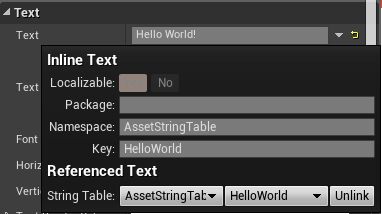Choose your operating system:
Windows
macOS
Linux
String Tables provide a way to centralize your localized text into one (or several) known locations, and then reference the entries within a string table from other assets or code in a robust way that allows for easy re-use of localized text.
Creating String Tables
String Tables can be defined in C++, loaded using a CSV file, or created as an Asset.
Creating String Tables in C++
String Tables can be created in C++ by using the LOCTABLE family of macros.
|
Macro |
Description |
|---|---|
|
|
Creates an empty string table instance. |
|
|
Creates a string table instance and populates it from the given CSV file. When using the _ENGINE variant, the file is relative to the Engine content directory, and when using the _GAME variant, the file is relative to the project content directory. |
|
|
Sets an entry in a string table. |
|
|
Sets optional meta-data for an entry in a string table. |
Example:
// Create and populate a string table using only C++
LOCTABLE_NEW("CodeStringTable","CodeStringTable");
LOCTABLE_SETSTRING("CodeStringTable","HelloWorld","Hello World!");
LOCTABLE_SETMETA("CodeStringTable","HelloWorld","Comment","This is a comment about hello world");
LOCTABLE_SETSTRING("CodeStringTable","GoodbyeWorld","Goodbye World!");
LOCTABLE_SETMETA("CodeStringTable","GoodbyeWorld","Comment","This is a comment about goodbye world");Creating String Tables Using CSV
String Tables defined in CSV can be loaded using the LOCTABLE_FROMFILE_X macros, or can also be imported to/exported from a String Table asset.
Example :
// Create and populate a string table from a CSV file
LOCTABLE_FROMFILE_GAME("CSVStringTable","CSVStringTable","StringTableCSV/TestStrings.csv");The CSV format used for string tables has two mandatory columns, "Key" and "SourceString," with any extra columns being parsed as meta-data for your string table entries.
Key,SourceString,Comment
"HelloWorld","Hello World!","This is a comment about hello world"
"GoodbyeWorld","Goodbye World!","This is a comment about goodbye world"Quotes in CSV files are escaped using two sets of quotes ("") rather than C-style escaping (\"), however other control characters in your string (including tabs and new-lines) should be escaped using C-style escaping.
CSV string tables loaded using the LOCTABLE_FROMFILE_X macros are monitored for changes, and are automatically re-imported if they change on the disk (this is for Editor builds only).
CSV string tables aren't staged automatically. It is recommended that you place your CSV string tables in a known folder and then add them to the Additional Non-Asset Directories to Package in your project's Packaging settings.
Creating a String Table Asset
String Table assets can be created using the Content Browser ( Add > Miscellaneous > String Table ), and can be managed through the String Table editor. The String Table editor cannot currently edit meta-data, however any meta-data imported from a CSV file is preserved.

String Table assets are binary, so they cannot be resolved if a merge conflict happens. We recommend that you keep the String Table assets more granular than when you are using C++ or CSV to minimize your conflict domain.
Referencing a String Table
You can reference string tables in C++, in INI files, or as an Asset.
Referencing a String Table in C++
String Tables can be referenced in C++ using either the
LOCTABLE
macro, or the static
FText::FromStringTable
function. The underlying logic is identical, although the macro is easier to type but will only work with literal values, whereas the function will work with both literal and variable arguments.
Referencing a String Table in the INI File
String Tables can be referenced in INI files using the
LOCTABLE
macro syntax.
Referencing a String Table Asset
String Tables can be referenced using
FText
properties.

Click the white arrow next to a text property to link that property instance to a string table entry, instead of defining your localized text inline.

Redirecting a String Table
We recommend that you avoid renaming or moving string tables when possible. However, if you need to rename or move a string table, there is a way to redirect whole tables, and to redirect individual keys. You can do this in INI files, or by redirecting a String Table Asset.
Redirecting a String Table in the INI File
String Tables can be redirected using an INI file. The following example will redirect an entire string table to point to another string table:
[Core.StringTable]
+StringTableRedirects=(OldStringTable="Foo",NewStringTable="Bar")If you want to redirect an entry in one string table to an entry in another string table, use the following example:
[Core.StringTable]
+StringTableRedirects=(StringTable="Foo",OldKey="Bar",NewKey="Baz")Redirecting a String Table Asset
Moving or renaming a String Table Asset will leave an Asset Redirector behind. This is processed and followed like any other Asset Redirector.